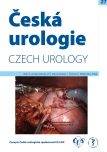Obesity and risk of prostate cancer
Authors:
Igor Hartmann; Milan Král; Šárka Kudláčková
Authors‘ workplace:
Urologická klinika Fakultní nemocnice Olomouc
Published in:
Ces Urol 2023; 27(1): 29-35
Category:
Original Articles
Overview
Major statement: Obesity is one of the most common diseases of civilization in the Czech Republic. It is associated with a more aggressive type of prostate cancer. We evaluated a group of patients who underwent radical prostatectomy. 86 % were overweight or obese, and yet we didn't demonstrate the expected higher incidence of more aggressive prostate cancer.
Aim: Obesity, as one of the most common diseases of civilization, which has a huge impact on the overall health status of the population. The increased morbidity and mortality of obese patienets is due to obesity itself and also due to the increased incidence of diseases that are not directly related to obesity, and yet their occurrence is more frequent in obese patients. Our aim was to demonstrate this association in obese patients with prostate cancer, which could lead tothe modification of recommendations regarding the early diagnosis of prostate cancer.
Material and methods: we evaluated a set of 200 patients who underwent robotic radical prostatectomy for prostate cancer between December 2017 and April 2019. Age, preoperative PSA (prostatic specific antigen), prostate volume, BMI ( Body Mass Index ), positive family history, postoperative stage according to TNM classification, and risk of aggressive prostate cancer according to ISUP (International Society of Urological pathology) grade group were evaluated in these patients.
Results: In our group, 34 % of patients were overweight (BMI 25–30) and 52 % of patients were obese (BMI > 30). In patients with BMI over 30, the volume of the prostate was statistically significantly greater than in the group with BMI <30 (p=0.034). We didn´t confirm the relationship between BMI and PSA level (p=0.944). Furthermore, we evaluated the relationship between BMI and cancer aggressiveness. We didn´t confirm a statistically significant difference (p=0,995) between BMI and aggressive prostate cancer. When evaluating postoperative staging, locally advanced prostate carcinoma (pT3 stage) was more common in patients with a BMI over 30 (p=0,100).
Conclusion: Although the percentage of obese patients in the Czech Republic is considerable, we didn´t confirm a clear connection between aggressive prostate cancer and obesity.
Keywords:
obesity – overweight – Radical prostatectomy – aggressive prostate cancer
Sources
1. Český statistický úřad. Jak jsou na tom Češi s chudobou, obezitou či sportováním? At <https://www. czso.cz/csu/stoletistatistiky/jak‑jsou‑na‑tom‑cesi‑s- chudobou‑obezitou‑ci‑sportovanim> Přístup 4. 10. 2022.
2. svod.cz. Epidemiologie zhoubných nádorů v České republice (2018). at <http://www.svod.cz/?sec=aktuality> Přístup 4. 10. 2022.
3. Veierod MB, Laake P, Thelle DS. Dietary fat intake and risk of prostate cancer: a prospective study of 25,708 Norwegian men. Int J Cancer. 1997; 73: 634–8.
4. Engeland A, Tretli S, Bjorge T. Height, body mass index and prostate cancer: a follow‑up of 950000 Norwegianmen. Br J Cancer. 2003; 89: 1237–42.
5. Andersson SO, Wolk A, Bergstrom R, et al. Body size and prostate cancer: a 20-year follow‑up study among 135006 Swedish construction workers. J Natl Cancer Inst. 1997; 89: 385–9.
6. Putnam SD, Cerhan JR, Parker AS, et al. Lifestyle andanthropometric risk factors for prostate cancer in acohort of Iowa men. Ann Epidemiol. 2000; 10: 361–9.
7. Buschemeyer WC, Freedland SJ. Obesity and prostate cancer: Epidemiology and Clinical Implications, Eur Urol. 2007; 52: 331–343.
8. Stephenson AJ, Klein EA. Epidemiology, Etiology, and Prevention of Prostate Cancer. In:Cambell‑Walsh Urology 11th edition. Elsevier 2016.
9. Freedland SJ, Terris MK, Platz EA, et al. Body mass index as a predictor of prostate cancer: Development versus detection on biopsy. Urology. 2005; 66: 108–113.
10. Allott EH, Masko EM, Freedland SJ. Obesity and prostate cancer: weighing th evidence. Eur Urol. 2013; 63: 800–809.
11. Fang X, Wei J, He X, et al. Quantitative association between body mass index and the risk of cancer: a global meta‑analysis of prospective cohort studies. Int.J.Cancer. 2018; 143: 1595–1603.
12. Schuurman AG, Goldbohm RA, Dorant E, van den Brandt PA. Anthropometry in relation to prostate cancer risk in the Netherlands Cohort Study. Am J Epidemiol. 2000; 151: 541.
13. Nilsen TI, Vatten LJ. Anthropometry and prostate cancer risk: a prospective study of 22,248 Norwegian men. Cancer Causes Control. 1999; 10: 269–75.
14. Rodriguez c, Freedland SJ, Deka A, et al. Body mass index, weigt change and risk of prostate cancer in the Cancer Prevention Study II Nutrition cohort. Cancer Epidemiol Biomarkers Prev. 2007; 16: 63–69.
15. Epstein JI, Egevad L, Amin MB, et al. The 2014 International Society of Urological Pathology (ISUP) consensus conference on Gleason grading of prostatic carcinoma. Am J Surg Pathol. 2016; 40: 244–52.
Labels
Paediatric urologist Nephrology UrologyArticle was published in
Czech Urology

2023 Issue 1
Most read in this issue
- The WHO Classification of Urinary and Male Genital Tumours 2022: news in the urinary tract neoplasms classification
- Rare complications post intravesical application of Bacillus-Calmette Guérin (BGG) vaccine
- Rare thrombosis of pampiniform plexus in a COVID-19 patient – a case report
- Obesity and risk of prostate cancer
